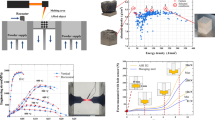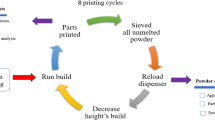Abstract
The main objective of this research is to develop a characterization method for parts fabricated in metal powder bed fusion (PBF) processes, a type of additive manufacturing (AM) process. To characterize conventionally manufactured parts, many methods and standards are available, while no comprehensive standards or methods are available for AM parts. In this paper, a mechanical property characterization method is proposed that involves statistical analysis to select sample sizes and test coupon design considerations for metal printing, printing parameters, and applicability of existing testing standards for metal PBF, in addition to several mechanical properties. As proof of concept for the proposed characterization method, material and mechanical property characterization of the metal printed (EOS M280) EOS maraging steel grade 300 material is presented along with selected sample lots and relative errors. The characterization method presented in this paper is applicable to any metal AM process.












Similar content being viewed by others
Abbreviations
- A, B:
-
Specimen notation for printed and heat-treated samples, respectively
- DED:
-
Directed energy deposition
- e :
-
Maximum acceptable sampling error, also called allowable relative error
- S :
-
Maximum acceptable difference between the true and sample means
- n :
-
Number of data points
- PBF:
-
Powder bed fusion
- σ :
-
Standard deviation
- X :
-
Data from test results
- \( \overline{X} \) :
-
The mean of the data
References
Gibson DR, Stucker B (2015) Additive manufacturing technologies; 3D printing, rapid prototyping, and direct digital manufacturing, 2nd Ed. Springer, New York
ISO 17296-3:2014, Additive manufacturing -- general principles -- part 3: main characteristics and corresponding test methods, 2014
Slotwinski J, Moylan S (2014) Applicability of existing materials testing standards for additive manufacturing materials, NISTIR 8005, National Institute of Standards and Technology, U.S Department of Commerce
ASTM F3122-14, ASTM International, 2014
Yasa E, Kempen K, Kruth J, Thijs, Humbeeck J (2010) Microstructure and mechanical properties of maraging steel 300 after selective laser sintering, in The 21st Annual International Solid Freefrom Fabrication Symposium- An Additive Manufacturing conference, Austin, Texas
Du W, Bai Q, Zhang B (2018) Machining characteristics of 18Ni-300 steel in additive/substractive hybrid manufacturing. Int J Adv Manuf Technol 95:2509–2519
Fortunato A, Lulaj A, Melkote S, Liverani E, Ascari A, Umbrello D (2018) Milling of maraging steel components produced by selective laser melting. Int J Adv Manuf Technol 95:1895–1902
Guo Z, Sha W (2004) Modelling the correlation between processing parameters and properties of maraging steels using artificial neural network. Comput Mater Sci 29:12–28
Demir, Previtsli B (2017) Investigation of remelting and preheating in SLM of 18Ni300 maraging steel as corrective and preventive measures for porosity reduction. Int J Adv Manuf Technol 93:2697–2709
Monkova K, Zetkova I, Kucerova L, Zetek M, Monka P, Dana M (2018) Study of 3D printing direction and effects of heat treatment on mechanical properties of MS1 maraging steel, Arch Appl Mech
EOS, Material data sheet, EOS GmbH-Electro Optical Systems, 2011
Suryawanshi J, Prashanth K, Ramamurthy U (2017) Tensile, fracture, and fatigue crack growth properties of a 3D printed maraging steel through selective laser melting. J Alloys Compd 725:355–364
ASTM, ASTM E122–17: standard sample size to estimate, with specified precision, the average for a characteristic of a lot or process, ASTM international, 2017
EOS, Machine and Software Parameters EOSINT M280, EOS GmbH-Electro Optical Systems, 2014
Yao Y, Huang Y, Chen B, Tan C, Su Y, Feng J (2018) Influence of processing parameters and heat treatment on the mechanical properties of 18Ni300 manufactured by laser based directed energy deposition. Opt Laser Technol:171–179
EOS, Operation-EOSINT M280-Laser-Sintering system for metal powder, Munchen: EOS
Bai Y, Yang Y, Wang D, Zhang M (2017) Influence mechanism of parameters process and mechanical properties evolution mechanism of maraging steel 300 by selective laser melting. Mater Sci Eng A:116–123
Yasa E, Deckers J, Kruth J, Rombouts M, Luyten J (2010) Charpy impact testing of metallic selective laser melting parts. Virtual Phys Prototyping:89–98
Branco R, Costa J, Berto F, Javad Razavi S, Martins Ferreria J, Capela C, Santos L and Antunes F (2018) Low-cycle fatigue behaviour of AISI 18Ni300 maraging steel produced by selective laser melting, Metals, vol. 8, no. 32
Hermann Becker T, Dimitrov D (2016) The achieveable mechanical properties of SLM produced maraging steel 300 components, Rapid Prototyp J, pp. 487–494
ASTM (2016) ASTM-E8-16a, standard test methods for tension testing of metallic materials, West Conshohocken: ASTM International
ASTM (2016) ASTM-E23-16b, standard test methods for notched bar impact testing of metallic materials, West Conshohocken, Pennsylvania: ASTM International
ASTM (2017) ASTM E18-17e1, standard test methods for Rockwell hardness of metallic materials, West Conshohocken, PA: ASTM International
ASTM (2011) ASTM E3-11, standard practice for preparation of metallographic specimens, ASTM International
ASTM (2017) ASTM B311-17, standard test method for density of powder metallurgy (PM) materials containing less than two percent porosity, PA: ASTM International
Tan C, Zhou K, Ma W, Zhang P, Liu M, Kuang T (2017) Microstructural evolution, nanoprecipitation behaviour and mechanical properties of selective laser melted high-performance grade 300 maraging steel. Mater Des 134:23–34
Aboulkhair NT, Everitt NM, Ashcroft I, Tuck C (2014) Reducing porosity in AlSi10Mg parts processed by selective melting. Addit Manuf 1-4:77–86
Acknowledgments
The authors would like to thank the funding agency, NAMIC (National Additive Manufacturing and Innovation Center) through grant 2017295, partner ST Engineering Land Systems, Singapore, for their in-kind contributions. Authors acknowledge the efforts of Senior Specialist Mr. Kai Lee, Digital Manufacturing and Design Centre, SUTD, Singapore, for assistance with specimen fabrication and testing.
Author information
Authors and Affiliations
Corresponding author
Additional information
Publisher’s note
Springer Nature remains neutral with regard to jurisdictional claims in published maps and institutional affiliations.
Rights and permissions
About this article
Cite this article
Raju, N., Kim, S. & Rosen, D.W. A characterization method for mechanical properties of metal powder bed fusion parts. Int J Adv Manuf Technol 108, 1189–1201 (2020). https://doi.org/10.1007/s00170-020-05298-7
Received:
Accepted:
Published:
Issue Date:
DOI: https://doi.org/10.1007/s00170-020-05298-7




